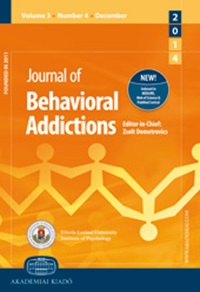在日常生活中,预期和体验到的奖励和缓解是如何影响与游戏相关的心理意象和游戏频率的:测试双途径假设
IF 6.6
1区 医学
Q1 PSYCHIATRY
引用次数: 0
摘要
背景与目的对游戏障碍发展的研究假设,在成瘾行为的早期阶段,强化学习的质量和使用期望的内容最初是有益的,在后期阶段逐渐变得更具补偿性。这种假设的转变可以反映在与游戏相关的心理意象以及在日常生活中玩电子游戏的决定中。我们招募了127名玩电子游戏的人。根据严格的诊断程序,个体被划分为休闲或风险游戏模式。研究人员在实验室评估了参与者对奖励和缓解的体验和期望,随后进行了为期14天的动态评估,询问他们与游戏相关的心理意象强度和游戏频率。除了群体差异外,我们还在结构方程模型中分别测试了群体间的满足和补偿路径。结果表明,与休闲游戏模式相比,高危游戏模式个体的心理意象、游戏频率、强化过程和使用期望都有所提高。游戏相关的心理意象只能通过表现休闲游戏模式的个体之间的补偿来预测,我们发现在任何模型中都没有对每日游戏频率的显著预测。讨论与结论结果表明,具有风险游戏模式的个体可能具有更强的习得强化随因。日常使用似乎不受这些偶然事件的影响,可能表明习惯行为。此外,研究结果也为想象欲望思想作为游戏行为背景下的一种特殊应对机制提供了一些支持。本文章由计算机程序翻译,如有差异,请以英文原文为准。
How expected and experienced reward and relief contribute to gaming-related mental imagery and gaming frequency in daily life: Testing a dual pathway hypothesis
Abstract Background and aims Research on the development of gaming disorder assumes that the quality of reinforcement learning as well as the content of use expectancies are initially rewarding in the early stages of the addictive behavior and becomes steadily more compensatory in the later stages. This assumed transition could be reflected in gaming-related mental imagery as well as the decision to play videogames in daily life. Methods We recruited 127 individuals who play videogames. Following a strict diagnostic procedure, individuals were either classified as showing casual or at-risk gaming patterns. The experience and expectancy of reward and relief were assessed in the laboratory, followed by a 14-day ambulatory assessment asking for gaming-related mental imagery intensity and playing frequency. Besides group differences, we tested a gratification and a compensation pathway in a structural equation model among groups separately. Results Results indicate that mental imagery and playing frequency as well as reinforcement processes and use expectancies are heightened among individuals showing at-risk gaming patterns as compared to casual gaming patterns. Gaming-related mental imagery was only predicted by compensation among individuals showing casual gaming patterns, and we found no significant predictions for daily gaming frequency in any of the models. Discussion and conclusions The results implicate that individuals with at-risk gaming patterns might hold stronger learned reinforcement contingencies. Daily usage seems unaffected by these contingencies, possibly indicative of habitualized behaviors. Additionally, the results provide some support for the consideration of imaginal desire thoughts as a specific coping mechanism in the context of gaming behaviors.
求助全文
通过发布文献求助,成功后即可免费获取论文全文。
去求助
来源期刊

Journal of Behavioral Addictions
PSYCHIATRY-
CiteScore
12.30
自引率
7.70%
发文量
91
审稿时长
20 weeks
期刊介绍:
The aim of Journal of Behavioral Addictions is to create a forum for the scientific information exchange with regard to behavioral addictions. The journal is a broad focused interdisciplinary one that publishes manuscripts on different approaches of non-substance addictions, research reports focusing on the addictive patterns of various behaviors, especially disorders of the impulsive-compulsive spectrum, and also publishes reviews in these topics. Coverage ranges from genetic and neurobiological research through psychological and clinical psychiatric approaches to epidemiological, sociological and anthropological aspects.
 求助内容:
求助内容: 应助结果提醒方式:
应助结果提醒方式:


